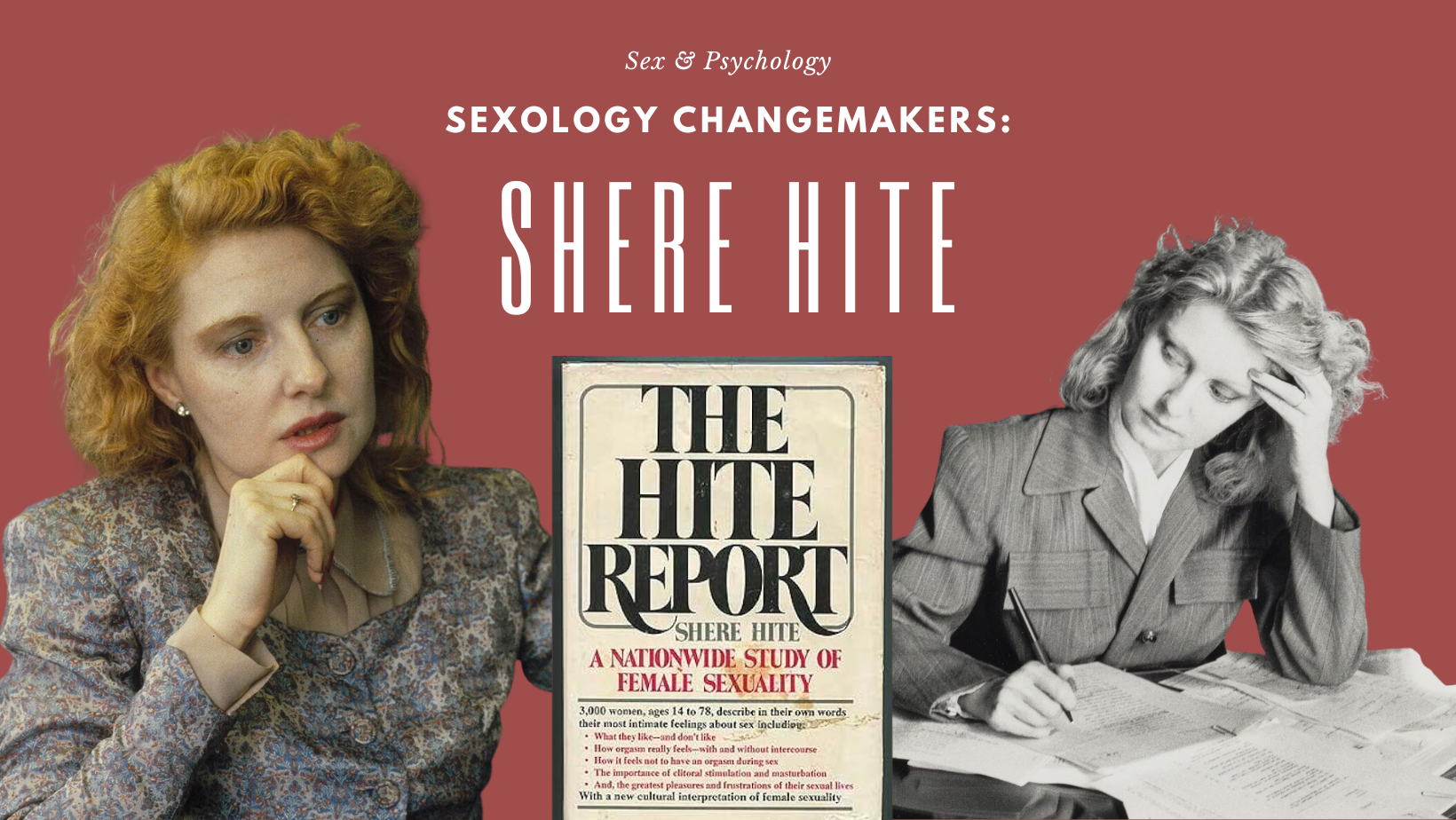Sexology Changemakers: Shere Hite
January 3, 2024 by Emily Mendelson
If you study the history of sex research, you’re likely to see certain names mentioned over and over again, such as Sigmund Freud, Alfred Kinsey, and William Masters. The contributions of these men were undoubtedly foundational. They offered novel theories and insights into human sexuality and helped to open up conversations about a subject that was rarely discussed at the time. However, something we rarely hear about in the history books are the women and persons of color who had a major influence on the field of sexology. Their contributions have not always received the same recognition.
In the coming weeks and months, Sex and Psychology will be highlighting some of the “hidden figures” in sex research that you might not have heard of, or might not know much about. To get us started, this blog highlights the life and work of Shere Hite, a sexology changemaker who surveyed over 3,000 women about sex and masturbation in the 1970s. We will review Hite’s biography, her book The Hite Report, and the importance of her contributions to sex research.
Who is Shere Hite?
Hite is originally from Missouri, but landed in Manhattan in 1967 to pursue a doctoral degree at Columbia in social history. While in New York, Hite became immersed in women’s activist circles, specifically, the National Organization for Women, and held miscellaneous modeling freelance jobs in order to make ends meet (these jobs later became a point of criticism against Hite and her studies, with individuals making the argument that no serious academic could or should be posing nude for outlets like Playboy).
As part of her research, Hite underwent a nationwide study of female sexuality to combat myths about the female orgasm and to focus on what women “think, feel, and truly experience” (Hite, 2004, p. 11). Masters and Johnson had just published their initial book outlining a four-stage human sexual response cycle in 1966, which claimed that thrusting during penetrative intercourse should provide enough clitoral stimulation for women to orgasm. Hite, alongside other sexologists such as Elisabeth Lloyd, then challenged the idea that (a) there was a difference between vaginal and clitoral orgasms, and that (b) women who could not reach orgasm from penetrative intercourse were sexually dysfunctional.
The Hite Report details the findings of Hite’s survey, which is one of the best selling nonfiction books ever (excluding textbooks and religious texts), with over 50 million copies sold. Clearly, the book was a sensation, and Hite made a litany of media appearances when the book was released. The Hite Report, however, was heavily criticized to the point that Hite eventually renounced her United States citizenship and moved to Germany. It is important to note that this criticism was heavily influenced by societal views that negatively viewed women’s sexual freedom and expression, and instead, dismissed Hite’s work as an act of ‘radical feminism.’
The Hite Report
The Hite Report: A Nationwide Study of Female Sexuality was first published in 1976 and contains data from four rounds of open-ended questionnaires that were physically filled out and mailed back to Hite, which she analyzed. Questions covered everything from masturbation to orgasms to penetrative sex to the sexual revolution!
Survey and Sampling Method
Because a majority of research is now done online, it may be hard to imagine distributing 100,000 surveys on paper, but that’s exactly what Hite did! She utilized a wide range of distribution methods and received over 3,000 replies (3,019 to be exact) from women all across the United States. She distributed the survey through national mailings to women’s groups and printed notices in various magazines so that readers could mail back their replies. Responses included participants from 49 states and various countries beyond the US, including Singapore and Germany.
The Questionnaires
All four of the questionnaires contained entirely open-ended questions that asked women to respond in as much detail as possible. This method of survey design allowed participants to reflect on their experiences and provide Hite with rich information about their sex lives. Participants responded because they wanted to “help add to our collective knowledge of ourselves” (p. 40*), for “cheap therapy” (p. 41), and because they were “sick of all the lies that are printed about women’s sexuality–especially that of lesbians” (p. 43), as just a few examples. Some participants also described how answering the survey itself was a form of sexual exploration and empowerment. Others found it to be more of a chore, yet completed it for the sake of a more accurate depiction of women’s experiences in sex research.
Because the data were all qualitative in nature, all the responses had to be processed and analyzed by hand. Hite described this process as follows:
“First, a large chart was made for each question asked…The many days required to copy the 1844 answers to each question were actually very valuable in that they provided extensive time for reflecting on the answers. Once the charts had been prepared, it was a relatively simple, though again time-consuming, process to categorize the answers. Usually patterns had begun to stand out during the copying process, so that the categories had more or less formed themselves. The figures were prepared by totaling the number of women in each category, following which representative quotes were selected. This procedure was followed for each of the 50-odd questions.” (p. 45)
Upon reading this analytic process, it appears to be not-unlike the many forms of thematic analysis that are widely popular among researchers today. At the time, however, this procedure was highly criticized for its qualitative and ‘subjective’ nature.
If you’re interested, you can view a version of the questionnaire online at the Hite Research Foundation website.
Results from The Hite Report
Two of the most important areas of inquiry for Hite were that of masturbation and the experience of orgasm for women. Regarding masturbation, Hite found that almost all participants were initially raised with the idea that masturbation was something dirty; over time, however, participants found it to be “a beautiful fulfilling gratification of the needs and pleasures of your body” (p. 66). Hite also identified six basic types of masturbation that women participated in that are described in detail. The vast number of quotes from participants revealed an incredible range of preferred methods of self-pleasure in women that were completely unrelated to penetrative intercourse.
Regarding orgasm, Hite found that women felt themselves under great pressure to orgasm during penetrative intercourse. However, with sex often ending at the point of the man’s orgasm, women were frequently left aroused yet unsatisfied, especially when this became a pattern in a relationship. Hite explains that “the right to orgasm has become a political question for women” (p. 111) when there is such a disparity in the experiences of orgasm between men and women during partnered sex. Additionally, Hite understood the long-held distinction between vaginal and clitoral orgasm to be incorrect, finding that most women experience orgasm as a result of clitoral stimulation.
Implications for Sex Research
Hite’s findings directly challenged that of Masters and Johnson – women who do not experience orgasm through penetrative intercourse are not sexually dysfunctional. Rather, the lack of orgasms women experience is due to a society that fails to recognize women’s sexuality and misunderstands how women experience pleasure. Hite’s approach to sex research introduced the role of culture and society into how individuals experience sex, particularly the way that “the reproductive model of sex exploits women” (p. 305). She concludes that “since sex is a historically and culturally constructed institution—not strictly a matter of biology and mechanics—the definition of sex can be changed and indeed should be changed” (p. 12).
The Disappearance of Shere Hite
Oscar-nominated, Emmy-winning documentary producer and director Nicole Newnham recently premiered The Disappearance of Shere Hite, a documentary about Hite’s life and research. The film depicts Hite (voiced by Dakota Johnson) and interviews individuals who were close to Hite while she was a student at Columbia, undergoing her research, and experiencing the fame that came alongside the popularity of The Hite Report. This documentary is a great way to learn more about Hite, and you can watch the trailer for the film here. We also had the opportunity to speak with Newnham on the podcast, so be sure to check out our conversations with her about Shere Hite and about making this documentary.
Taken altogether, Shere Hite is an under-recognized changemaker in the field of sexology despite the popularity of her book (note that she actually published several, but we focused on the original because it was the most influential). Her work drastically changed the way that many conceptualize sex: from that of solely biological process to something that is greatly influenced by cultural and social norms. She was a staunch champion of a sexual revolution that honored women’s pleasure, and her approach to research constantly reminds us of the necessity of forwarding individuals’ own experiences.
Want to learn more about Sex and Psychology? Click here for more from the blog or here to listen to the podcast. Follow Sex and Psychology on Facebook, Twitter (@JustinLehmiller), or Reddit to receive updates. You can also follow Dr. Lehmiller on YouTube and Instagram.
*All page numbers are taken from the 2004 printing of The Hite Report.
Image Credit: Bernard Gotfryd and Bettye Lane Photographs; collage made with Canva

Dr. Justin Lehmiller
Founder & Owner of Sex and PsychologyDr. Justin Lehmiller is a social psychologist and Research Fellow at The Kinsey Institute. He runs the Sex and Psychology blog and podcast and is author of the popular book Tell Me What You Want. Dr. Lehmiller is an award-winning educator, and a prolific researcher who has published more than 50 academic works.
Read full bio >


